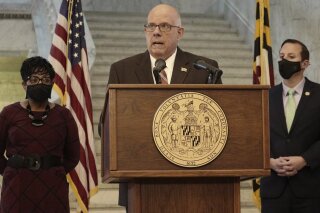Hogan, legislative leaders, outline $3.9B in federal relief

Maryland Gov. Larry Hogan, a Republican, announces a bipartisan budget agreement to allocate $3.9 billion in federal funding that the state expects to receive through the American Rescue Plan Act during a news conference with legislative leaders on Wednesday, March 31, 2021 in Annapolis. House Speaker Adrienne Jones, a Democrat, is standing left, and Senate President Bill Ferguson, a Democrat, is standing right. (AP Photo/Brian Witte)
ANNAPOLIS, Md. (AP) — Maryland’s $3.9 billion in federal pandemic relief will be used to bolster the state’s unemployment insurance fund, fuel state recovery efforts, reopen schools and expand broadband technology, Gov. Larry Hogan announced in a bipartisan pact with legislative leaders Wednesday.
The Republican governor said $1.1 billion will be dedicated to stabilizing unemployment insurance tax rates for businesses for calendar years 2022 and 2023.
“This shoring up of the unemployment system will help us to continue helping those who need it most, while also ensuring that we can provide continuing tax relief for struggling businesses,” Hogan said, joined by Senate President Bill Ferguson and House Speaker Adrienne Jones at news conference.
Ferguson, a Baltimore Democrat, highlighted $300 million in broadband technology investments. That will include $128 million to improve network infrastructure, $75 million for service fee and device subsidies and $45 million for municipal broadband grants.
Too many people have struggled from a digital divide worsened by the COVID-19 pandemic, Ferguson said, as more people worked from home and students tried to learn online because of closed offices and schools.
“For far too many Marylanders, this transition has not been easy and has not been possible, not to any fault of any individual Marylanders or lack of desire or initiative, but because the technical infrastructure, knowledge and access was simply not available,” Ferguson said.
All three officials emphasized bipartisan cooperation in what Hogan described as a “historic budget accord.”
“Together we will be able to invest an additional half a billion dollars in shovel ready construction projects to get Marylanders back to work,” said Jones, a Baltimore County Democrat.
The state will use $800 million of the federal funds to supporting existing state pandemic relief. The General Assembly, which is controlled by Democrats, passed a sweeping measure initially proposed by Hogan early in the legislative session.
More than $600 million will be used to support the reopening of schools. That includes $481 million to address pandemic-related costs, $80 million to support improved HVAC and ventilation systems and $46 million to focus on the long-term impact of learning loss over the last year.
Another $500 million will support the Maryland Department of Transportation and the Maryland Transportation Authority in improving services and infrastructure.
About $300 million will be dedicated to state residents in need, including $140 million to support the higher-then-estimated caseload cost in the Temporary Cash Assistance program and $50 million to support state efforts to aid people struggling with utility bills.
The General Assembly, which is scheduled to adjourn on April 12, is nearing final votes on the state’s roughly $50 billion budget for the next fiscal year. Lawmakers have described how the enormous amount of federal aid reshaped what looked like a developing budget crisis last year at the start of the pandemic into the ability to address projected deficits through fiscal year 2024.
